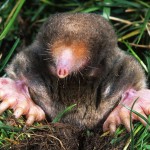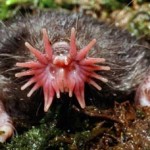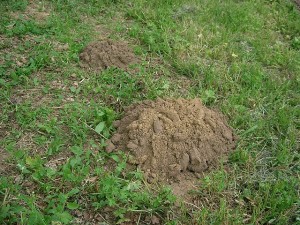Mole Removal Minneapolis MN
Moles are one of the common species of wildlife that we are called upon to control in Minnesota. Although moles pose no threat to humans, moles can quickly destroy the lawn or garden you have worked so hard to make grow. Both the Eastern Mole and Star Nosed Mole call Minnesota home. Unlike gophers, moles do not eat vegetation. Moles eat only “live” food. They eat earthworms, insect larvae, beetle grubs, ants, and any ground dwelling insects.
Moles Go Where The Food Is!
(That is why Juicy Fruit gum, poison peanuts and other home remedies do not work, they are not alive!) The mole simply follows the food.
Moles are active day and night throughout the year, but they are most active near the earth’s surface during the spring and fall on damp days or following rain showers or watering your lawn. When the ground surface becomes frozen in the winter, or very dry during the summer, moles use only the deeper burrows. During the winter and dry summers the mole will tunnel down to where the insects are. Once the ground surface becomes frozen in the winter, or very dry during the summer, moles use only the deeper burrows. At these times the homeowner sometimes gets a reprieve from the mole’s destructive surface activity.
The life expectancy of a mole is approximately 3 years due to its extremely high metabolic rate. Moles are very territorial and won’t tolerate another mole in its tunnel system. A single mole can cause an enormous amount of destruction to their lawn and landscaping. A single mole can turn a nice manicured lawn into a mess of tunnels and dirt piles.
Eastern Mole
The Eastern Mole (Scalopus aquaticus) is small, weighing only about 3 oz. and is about 6 inches long. They live for about 2-3 years. They breed in January, and after a 45 day pregnancy, give birth to 2-4 young. The eastern mole is larger than the star-nosed mole. Fur would be dark brown to grayish, and it has a silvery sheen. The muzzle has no fur, nor do paws or tail.
Star Nosed Mole
The Star-Nosed Mole (Condylura cristata) is the another potentially destructive mole species common in Minnesota. The star-nosed mole is covered in thick, blackish-brown, water-repellent fur, and has large, scaled feet and a long, thick tail, which appears to function as a fat storage reserve for the spring breeding season. The mole’s most distinctive feature is a circle of 22 mobile, pink, fleshy tentacles called rays at the end of the snout, from which it derives its name. These are used to identify food by touch, such as worms and other insects.
Mole Damage
Moles cause damage not by eating the roots of your beloved plants, shrubs and trees, but by accidentally uprooting them in their search for food. These little dirt diggers can dig surface tunnels at approximately 15 to 18 feet an hour and as much as 150-200 feet a day.
The most common complaints include the following:
- “Ridges” from tunnels all over yard
- Large mole hill piles of dirt
- Ground feels spongy & looks unsightly
- General lawn & landscape destruction
For these reasons, many people wish to have this nuisance animal removed from the property ASAP Lethal trapping and removal is the one and only way. Although several companies have tried to create mole poisons, none seem to work well. These traps are not for amateurs to set. Mole trapping is an art best left to the professionals. The traps have to be set jussst riiiight or else they will not work.
If you have seen indentations in your lawn, or small mounds and are not sure what they are, it’s time to call a Minnesota Wild Animal Management Expert. They are the experts at humane removal of any Moles that may be living around your home and causing damage to your yard and plants. They will also take steps to ensure the moles do not return to your yard.






